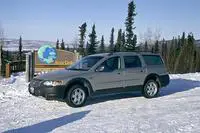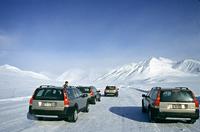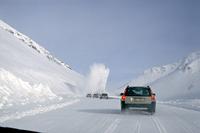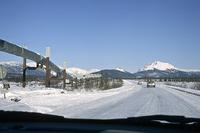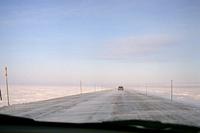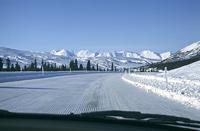Review: 2003 Volvo XC 70 Cross Country Wagon In Snowy Alaska
SEE ALSO: Volvo Buyer's Guide
DRIVING DOWN THE ROAD WITH CAREY RUSS
Usually, I drive a car for a week, around town and on the local
highways and byways to see how it works in the everyday world.
City parking hassles and commute traffic are balanced by highway
driving on both the Interstate and the occasional uncrowded
backroad. I drive maybe 250 miles, on average. This week is a bit
different.
I spent most of last week far from home. To be more exact, I
was in Alaska, to drive a Volvo XC70 from Anchorage to Prudhoe
Bay. The program involved two consecutive 500-mile days, split
between two drivers for 250 miles each, each day. Although some
of that mileage was on clear pavement, most was on ice or snow, or
both, over pavement or dirt.
OK, I know what you're thinking. Why use the XC70, known as
the Cross Country until this year? Volvo has a new SUV, the
XC90. Why not use that instead? There are several reasons. First,
according to Volvo Public Relations Manager Soren Johannsen,
``XC90 owners are more likely to head toward Newport Beach;
XC70 owners go to the Sierras.'' (Volvo's U.S. base is in Irvine, in
Southern California, hence the S. Cal references.) Secondly, XC90s
are in short supply. Volvo has a very popular vehicle in the XC90.
Fifty percent were pre-sold when it was announced. And the supply
is more limited than was originally intended, as a shipwreck in the
English Channel resulted in the loss of a large number of early-
production XC90s.
The XC70 has some changes for 2003 that make it an ideal
adventure vehicle, even if your idea of adventure doesn't include
driving in extreme conditions. Although it looks pretty much the
same as it has since its model year 2001 introduction, the 2003
XC70 has the 2.5-liter five-cylinder engine that is standard in the
larger XC90. Rated at 208 horsepower at 5,000 rpm, with 236 lb-ft
of torque available between 1,500 and 4,500 rpm, its output is up
significantly from the previous 2.4-liter engine's 197 horsepower
and 210 lb-ft.
Previous Cross Country models used an all-wheel drive (AWD)
system based on a center viscous coupling. The 2003 XC70 uses
the same AWD system as the XC90, developed in collaboration
with Swedish manufacturer Haldex. Basically hydraulic in action, it
reacts very quickly to changing road conditions - within 1/7 of a
wheel's rotation. Electronic sensors and controls can modify the
system's response characteristics, for better operation in conditions
ranging from dry pavement to loose gravel, snow, ice, or mud.
Additionally, the XC70s used for this adventure were equipped
with the Dynamic Stability Traction Control (DSTC) system for
surefootedness on the dicey surfaces expected. And the XC70's 8.2
inches of ground clearance could prove useful in snow, mud, or on
the paved highway if debris is suddenly encountered. All of the
XC70s on this trip were fitted with studded tires, a necessity for
driving any distance on ice and snow.
Our driving route took us on almost any possible cold-weather
winter driving surface. Alaska is having a mild, dry winter so far
this year, and the first 250 or so miles from Anchorage to Glen
Allen were mostly on dry asphalt, with intermittent patches of ice
and snow. The XC70 just yawned, and the various traction and
stability systems took it easy. From Glen Allen north to Fairbanks,
it got a little trickier. Patches of dry, plowed pavement were
interspersed with ever-longer sections of ice, with serious grooves
from plowing. Even from the passenger seat I could feel the tires
tramlining in the grooves, just like in the rain grooves in the
highways at home, and also feel the AWD and stability control
systems at work. It was all very subtle, and not at all intrusive.
Conditions were similar to those experienced by anyone in the
snowy parts of the Lower 48, and the XC70 handled them with
aplomb.
The first day was a warm-up. The second day was much more
intensive and intense. A pre-dawn convoy start got us out of
Fairbanks on icy pavement, which gave way to improved dirt north
of the city. This is not my normal driving environment, and I was
tiptoeing across some occasionally very slick surfaces, but the
Haldex, DSTC, and especially, studs were doing their jobs well.
Then, on a straight, downhill section of dirt road with patches of ice
and snow, the car suddenly moved towards the verge. Unseen ice
perhaps? Deeper than anticipated snow? I didn't have time to think,
and reacted instinctively, turning the wheels toward the skid and
gently getting off the gas to transfer weight forward and get more
grip on the front tires. Nice try, but...by then the surface was pure
snow and ice and the outside front tire had discovered that the
apparently level snow on the outside of the road masked a drop-off.
And I'm headed towards the only road sign for miles. I got by the
sign, and stopped, halfway into the snow on the road side. No
damage except to my ego, no airbags deployed. I apologize to my
co-driver, who seems as surprised as I am. A quick try at reverse
shows us good and stuck, with the tires spinning furiously in
powder snow.
More cars come along, and we attempt to tow my stuck XC70
out with another one. After much digging, and occasionally settling
deeper, it gets enough traction so that, with the assist of the other
XC70, it comes free. Hey, that 3,300-lb towing capacity comes in
handy, and might even be a little conservative for short-term use.
Volvo's tow ropes, with a built-in clevis, are strong and easy to use,
too. The car is commandeered by the Swedish Volvo technicians,
who remove snow from the engine compartment, check it out,
pronounce it fit, and drive on in it. My co-driver and I move to
another car.
Back in the saddle, I head north with extreme caution. Although
I'm on solid ice and snow, there are no further incidents, and I
quickly regain confidence. Following the local customs, I also stay
as close to the center of the road as possible, slowing and moving
to the right only when there is oncoming traffic. And there is a
surprising amount of oncoming traffic, as the Dalton Highway is the
only road between Southern Alaska and the Prudhoe Bay oil fields.
It was built to support the Alaska Pipeline, which it parallels. There
are plenty of pipeline inspection trucks, and many large tractor-
trailer rigs. The semi drivers are not slow.
Alaska scenery south of the Brooks Range is North American
Alpine. It looks similar to parts of the Sierra Nevada, the Cascades,
or the Rockies, but everything is bigger. You pass through the high
country in the Lower 48 in a couple of hours at most. In Alaska,
that's all there is, all day long. ``Beautiful'' barely begins to describe it.
We stop for lunch and a driver change at Coldfoot, and then on
to the North Slope over Atigun Pass, which has just been re-opened
after being closed due to snow and high winds. Although the rolling
hills and wind-sculpted bluffs directly north of the pass could pass
for parts of Wyoming, the tundra is unlike anything else on this
planet. In late winter conditions, the Dalton Highway seems like a
causeway through a frozen sea, with the ever-present wind blowing
a wispy cirrus of snow across the road. When the wind picks up,
visibility decreases drastically, to near whiteout. Ditto when a
southbound semi passes. The XC70's low center of gravity and
excellent aerodynamic stability, even in crosswinds, help to make
the drive safer and less stressful on both the driver and passenger.
And it's not possible to praise Volvo seats enough. I was exhausted
after each day, but from mental concentration, not physical
discomfort. Four-plus hours at a stretch in a Volvo seat is not at all
unpleasant.
The XC70 proved to be an excellent vehicle for Arctic
conditions, and should work in any other loose and slippery stuff,
too. I've driven the earlier version in deep mud, and it had no
problems at all, so the Haldex-based AWD system should do fine
there. The modern electronic control systems worked as well or
better than old-style low-tech four-wheel drive, with more comfort.
But a quick note to anyone regularly driving a vehicle so equipped
in slippery conditions: Volvo's DSTC, and all other similar systems,
limit wheelslip by gentle application of the brakes to one or more
wheels. This works, and well, but upon stopping after long
stretches of ice the aroma of hot brakes was very apparent. The
brakes worked fine, but being used that much it would be an
excellent idea to check the pad thickness at regular, short, intervals.
SPECIFICATIONS
2003 Volvo XC70 Cross-Country Wagon
Base Price $ 33,870
Price As Tested $ 39,020 (approximate)
Engine Type dual overhead cam 20-valve
light-pressure turbocharged
and intercooled inline 5-cylinder
Engine Size 2.5 liters / 152 cu. in.
Horsepower 208 @ 5000 rpm
Torque (lb-ft) 236 @ 1,500-4,500 rpm
Transmission 5-speed electronically-controlled
automatic with Geartronic manual
shift mode
Wheelbase / Length 108.8 in. / 186.3 in.
Curb Weight 3,827 lbs.
Pounds Per Horsepower 18.4
Fuel Capacity 18.5 gal.
Fuel Requirement unleaded premium gasoline
(91 octane) recommended
Tires n/a
Brakes, front/rear vented disc / solid disc,
antilock standard
Suspension, front/rear independent MacPherson strut
/independent multilink
Ground clearance 8.2 inches
Drivetrain front engine, all-wheel drive
PERFORMANCE
EPA Fuel Economy - miles per gallon
city / highway / observed 18 / 25 / 20
0 to 60 mph 8.4 sec
Towing capacity 3,300 lbs
OPTIONS AND CHARGES (estimated)
Premium Package - includes:
leather seating surfaces, power-adjustable passenger
seat, power glass sunroof, trip computer $ 2,595
Dynamic Stability Traction Control system $ 695
200-watt 4-CD in-dash sound system $ 1,200
Engine block heater $ n/a
Destination charge $ 660



